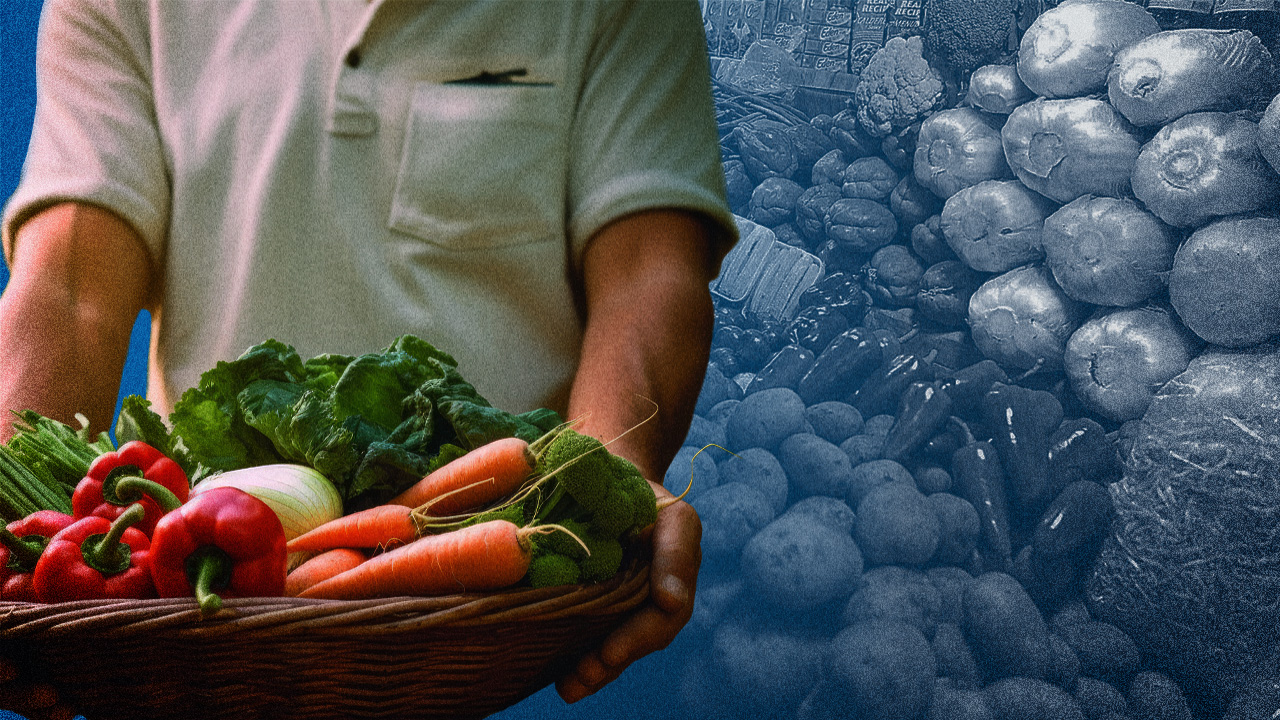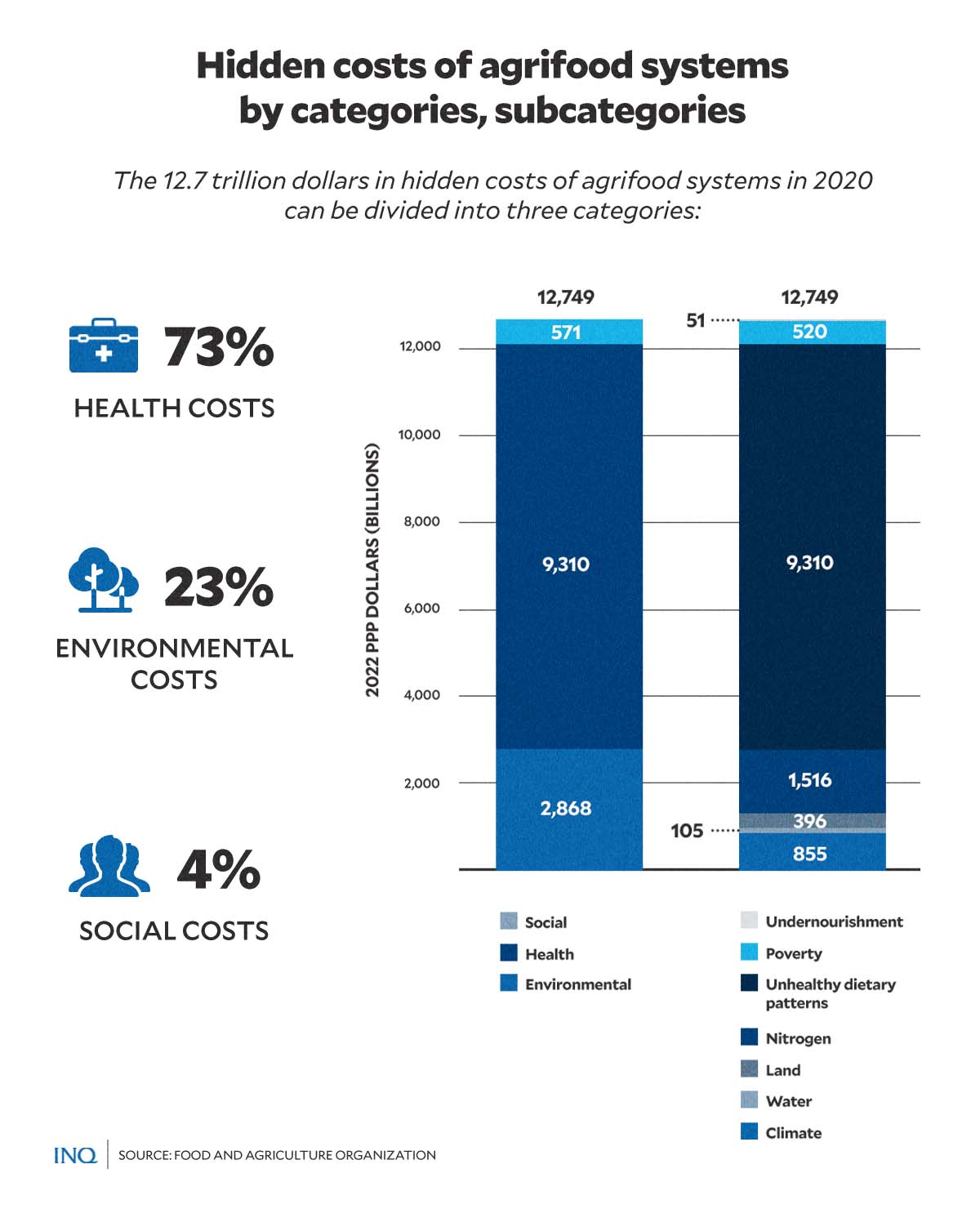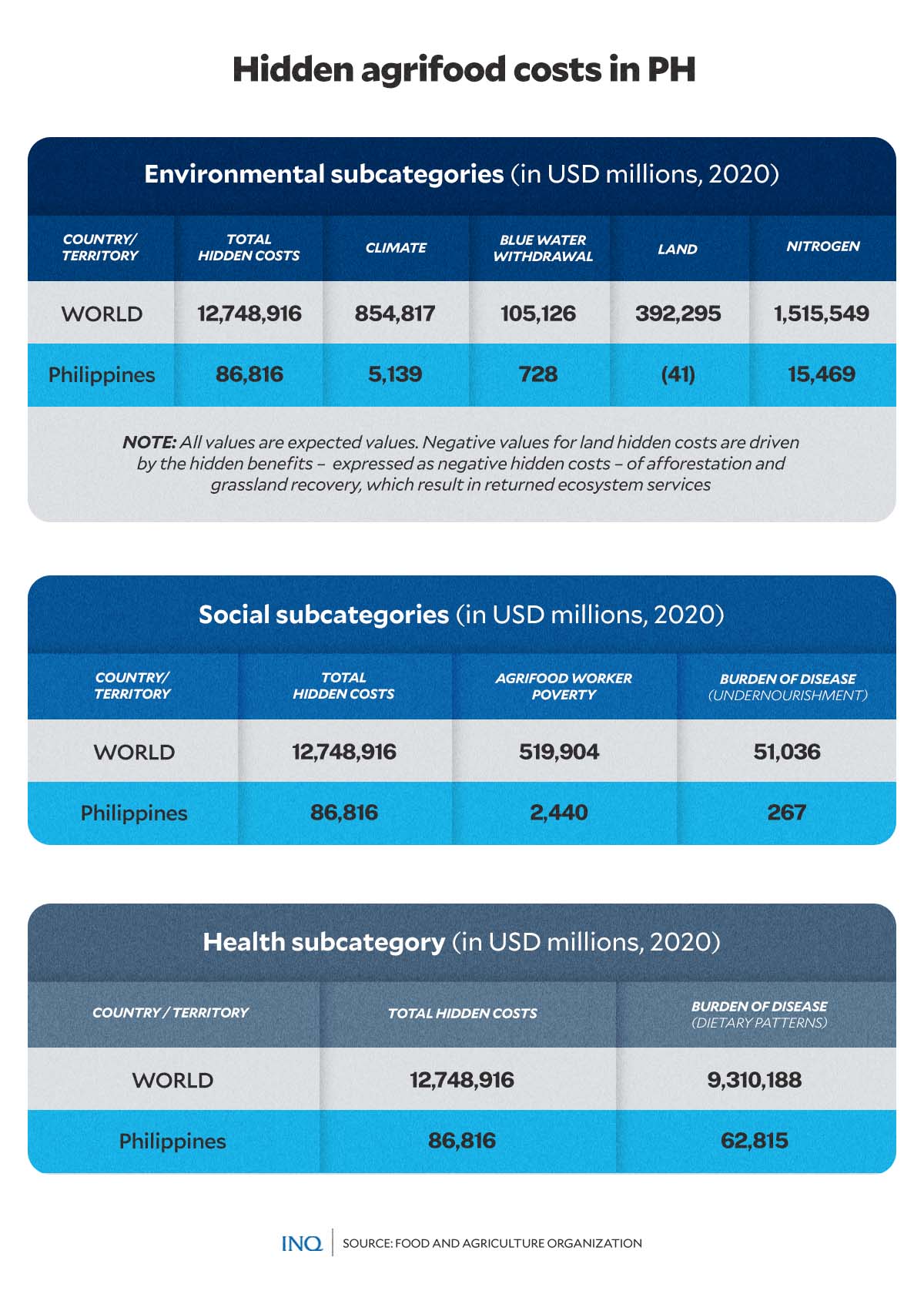Hidden costs of food production reach trillions—FAO
MANILA, Philippines—A recent ground-breaking analysis by a specialized agency of the United Nations (UN) has uncovered that the global food system may be costing the world economy at least 10 trillion US dollars annually due to its impact on human health, environment, and society.
In the 2023 edition of The State of Food and Agriculture (SOFA) report, for the first time, the Food and Agriculture Organization of the United Nations (FAO) calculated the environmental, health, and social hidden costs of agri-food systems for 154 countries — including the Philippines.
According to the UN agency, hidden costs refer to the unaccounted-for expenses that are not directly reflected in the prices of food. These can include environmental, health, and social costs associated with the global agri-food systems or the process of food production, transportation, processing, and consumption.
“Agri-food systems generate significant benefits to society, including the food that nourishes us and jobs and livelihoods for over a billion people,” FAO said.
“However, their negative impacts due to unsustainable business-as-usual activities and practices are contributing to climate change, natural resource degradation, and the unaffordability of healthy diets,” it added.
Article continues after this advertisementThe report found that while agri-food systems provide nourishment and sustain economies, they also exact an equivalent of 12.7 trillion US dollars annually on health, environment, and society across the globe.
Article continues after this advertisementThe figure is equivalent to nearly 10 percent of the global Gross Domestic Product (GDP) in 2020, or at least 35 billion US dollars per day.
Unhealthy diets, emissions, poverty
FAO’s analysis highlighted that the biggest hidden costs, equivalent to 73 percent, are driven by unhealthy diets that are ”high in ultra-processed foods, fats, and sugars, leading to obesity and non-communicable diseases,” which can eventually lead to labor productivity losses.
Data showed that these costs are felt across 154 countries but particularly high among high- and upper-middle-income countries.
According to the UN agency, health-related costs are generally not reflected in the price of food.
The study also found that one-fifth of the total hidden costs are environment-related. These environmental damages often do not factor into the price of food. However, they can have long-term costs for society, including the need for environmental restoration and loss of ecosystem services.
Agriculture can have significant impacts on the environment, including deforestation, soil degradation, water contamination, and loss of biodiversity. In this case, the costs are linked to greenhouse gas and nitrogen emissions, land-use change, and water use.
“This is a problem that affects all countries, and the scale is probably underestimated due to data limitations,” FAO explained.
At least 4 percent of the global quantified hidden costs of agri-food systems are due to social costs. These include poverty, productivity losses linked with undernutrition, food loss and waste, and fertilizer leakage.
‘We pay them, but not equally’
According to FAO, low-income countries are proportionately the hardest hit by hidden costs of agri-food systems, which represent more than a quarter of their GDP, as opposed to 11 percent in middle-income countries and less than 8 percent in high-income countries.
“[T]his reveals a stark economic disparity,” said FAO Director-General Qu Dongyu.
“Clearly, addressing poverty and undernourishment remains a priority for low-income countries, as these account for about half of all hidden costs quantified in these countries,” he continued.
In low-income countries, hidden costs associated with poverty and undernourishment are the most significant.
Meanwhile, the hidden costs for these were approximately 86,816 billion US dollars — the third highest among Southeast Asian countries, or next to Thailand and Indonesia, with 106 and 319 billion US dollars worth of hidden costs, respectively.
In the Philippines, health costs or the burden of disease (productivity losses from dietary patterns) had the largest share (72%) among hidden costs, followed by environmental costs (around 25%), and social costs (3%).
Call to action
“In the face of escalating global challenges – lack of food availability, food accessibility, and food affordability due to the climate crisis, biodiversity loss, economic slowdowns and downturns, worsening poverty, and other overlapping crises – we find ourselves standing at a critical juncture,” said Dongyu.
“The choices we make now, the priorities we set, and the solutions we implement will determine the trajectory of our shared future. Consequently, the decisions we make about global agri-food systems must acknowledge these interrelated challenges,” he added.
FAO noted that preliminary results from the study should not be viewed as a definitive assessment but rather as a starting point for debate and dialogue. The UN agency said the report aims to help see the big picture of the hidden costs of agri-food systems.
It added that action to address these costs will have to be taken at the country level.
“I hope that this report will serve as a call to action for all partners – from policymakers and private-sector actors to researchers and consumers – and inspire a collective commitment to transform our agri-food systems for the betterment of all,” Dongyu said.
RELATED STORIES:
Oxford Economics: Climate change makes food costlier in PH, Asean




